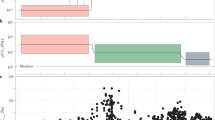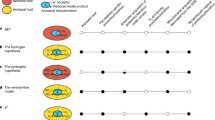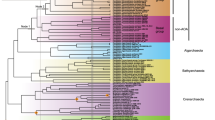Abstract
Earth is over 4,500 million years old. Massive bombardment of the planet took place for the first 500–700 million years, and the largest impacts would have been capable of sterilizing the planet. Probably until 4,000 million years ago or later, occasional impacts might have heated the ocean over 100 °C. Life on Earth dates from before about 3,800 million years ago, and is likely to have gone through one or more hot-ocean 'bottlenecks'. Only hyperthermophiles (organisms optimally living in water at 80–110 °C) would have survived. It is possible that early life diversified near hydrothermal vents, but hypotheses that life first occupied other pre-bottleneck habitats are tenable (including transfer from Mars on ejecta from impacts there). Early hyperthermophile life, probably near hydrothermal systems, may have been non-photosynthetic, and many housekeeping proteins and biochemical processes may have an original hydrothermal heritage. The development of anoxygenic and then oxygenic photosynthesis would have allowed life to escape the hydrothermal setting. By about 3,500 million years ago, most of the principal biochemical pathways that sustain the modern biosphere had evolved, and were global in scope.
This is a preview of subscription content, access via your institution
Access options
Subscribe to this journal
Receive 51 print issues and online access
$199.00 per year
only $3.90 per issue
Buy this article
- Purchase on Springer Link
- Instant access to full article PDF
Prices may be subject to local taxes which are calculated during checkout

Similar content being viewed by others
References
Newman, J. H. Apologia Pro Vita Sua (Longmans, London, 1980).
Wetherill, G. W. Formation of the Earth. Annu. Rev. Earth Planet. Sci. 18, 205 (1990).
Ahrens, T. J. in Origin of the Earth (eds Newsom, H. E. & Jones, J. H.) 211–227 (Oxford Univ. Press, New York, 1990).
Lewis, J. S. & Prinn, R. G. Planets and their Atmospheres (Academic, Orlando, 1984).
Hunten, D. M. Atmospheric evolution of the terrestrial planets. Science 259, 915–920 (1993).
Watson, A. J., Donahue, T. M. & Kuhn, W. R. Temperatures in a runaway greenhouse on the evolving Venus. Earth Planet. Sci. Lett. 68, 1–6 (1984).
Bell, D. R. & Ihinger, P. D. The isotopic composition of hydrogen in nominally anhydrous mantle minerals. Geochim. Cosmochim. Acta 64, 2109–2118 (2000).
Yung, Y., Wen, J.-S., Moses, J. I., Landry, B. M. & Allen, M. Hydrogen and deuterium loss from the terrestrial atmosphere: a quantitative assessment of non-thermal escape fluxes. J. Geophys. Res. 94, 14971–14989 (1989).
Trieloff, M., Kunz, J., Clague, D. A., Harrison, D. & Allegre, C. J. The nature of pristine noble gases in mantle plumes. Science 288, 1036–1038 (2000).
Carr. M. Water on Mars (Cambridge Univ. Press, Cambridge, 1996).
Halliday, A. N. Terrestrial accretion rates and the origin of the Moon. Earth Planet. Sci. Lett. 176, 17–30 (2000).
Melosh, H. J. in Origin of the Earth (eds Newsom, H. E. & Jones. J. H.) 69–83 (Oxford Univ. Press, Oxford, 1990).
Milton, J. Nature Unimpaired by Time (Latin verse, trans. W. Cowper, 1791) in The Poetical Works of William Cowper (Frederick Warne, London, New York, 1908).
Wilde, S. A. et al. Evidence from detrital zircons for the existence of continental crust and oceans on the Earth 4.4 Gyr ago. Nature 409, 175–178 (2001).
Stern, R. A. & Bleeker, W. Age of the world's oldest rocks refined using Canada's SHRIMP: the Acasta Gneiss Complex, Northwest Territories, Canada. Geosci. Can. 25-1, 27–31 (1998).
Campbell, I. H. & Taylor, S. R. No water, no granites, no oceans, no continents. Geophys. Res. Lett. 10, 1061–1064 (1983).
McKay, D. S. et al. Search for past life on Mars: possible relic biogenic activity in Martian meteorite ALH84001. Science 273, 924–930 (1996).
Kasting, J. F., Whitmire, D. P. & Reynolds, R. T. Habitable zones around main sequence stars. Icarus 101, 108–128 (1993).
Lewis, C. S. Perelandra (Voyage to Venus) (John Lane the Bodley Head, London, 1943).
Zuber, M. T. et al. Internal structure and early thermal evolution of Mars from Mars global surveyor topography and gravity. Science 287, 1788–1793 (2000).
Sleep, N. H. & Zahnle, K. Refugia from asteroid impacts on early Mars and the early Earth. J. Geophys. Res. 103, 28529–28544 (1998).
Sagan, C. & Chyba, C. The early Sun paradox: organic shielding of ultraviolet-labile greenhouse gases. Science 276, 1217–1221 (1997).
Zahnle, K. Photochemistry of methane and the formation of hydrocyanic acid (HCN) in the Earth's early atmosphere. J. Geophys. Res. 91, 2819–2834 (1986).
Pavlov, A., Kasting, J. F., Brown, L. L., Rages, K. A. & Freedman, R. Greenhouse warming by CH4 in the atmosphere of early Earth. J. Geophys. Res. 105, 11981–11990 (2000).
Kress, M. E, Zahnle, K. & McKay, C. P. Impact production of CH4 on early Earth and Mars. EOS 81, F809 (2000).
Drake, M. J. Accretion and primary differentiation of the Earth. Geochim. Cosmochim. Acta 64, 2363–2370 (2000).
Schidlowski, M. in Instruments, Methods and Missions for Astrobiology (Proc. Soc. Photo-Opt. Instrument. Engs 3441) 149–157 (Bellingham, WA, 1998).
Nisbet, E. G. The Young Earth: An Introduction to Archaean Geology (Cambridge Univ. Press, Cambridge, 1987).
Nisbet, E. G. & Fowler, C. M. R. Some liked it hot. Nature 382, 404–405 (1996).
Nutman, A. P., Mojzsis, S. J. & Friend, C. R. L. Recognition of >3850 Ma water-lain sediments and their significance for the early Earth. Geochim. Cosmochim. Acta 61, 2475–2484 (1997).
Schidlowski, M. A 3,800 million-year old record of life from carbon in sedimentary rocks. Nature 333, 313–318 (1988).
Schidlowski, M. & Aharon, P. in Early Organic Evolution: Implications for Mineral and Energy Resources (eds Schidlowski., M. et al.) 147–175 (Springer, Berlin, 1992).
Mojzsis, S. J. et al. Evidence for life on Earth 3800 million years ago. Nature 384, 55–59 (1996).
Rosing, M. T. 13C-depleted carbon in >3700 Ma seafloor sedimentary rocks from West Greenland. Science 283, 674–676 (1999).
Awramik, S. M. in Early Organic Evolution: Implications for Mineral and Energy Resources (eds Schidlowski., M. et al.) 435–439 (Springer, Berlin, 1992).
Lowe, D. R. Abiological origin of described stromatolites older than 3.2Ga. Geology 22, 387–390 (1994).
Buick, R. Dunlop, J. S. R. & Groves, D. I. Stromatolite recognition in ancient rocks: an appraisal of irregularly laminated structures in an early Archaean chert-barite unit from North Pole, Western Australia. Alcheringa 5, 161–181 (1981).
Walsh, M. M. Microfossils from the early Archean Onverwacht Group, Barberton Mountain land, South Africa. Precambrian Res. 54, 271–293 (1992).
Schopf, J. W. & Packer, B. M. Early Archean (3.3 billion to 3.5 billion year old) microfossils from Warrawoona Group, Australia. Science 237, 70–73 (1987).
Westall, F. de Wit, M., Dann, J., van der Gaast, S. de Ronde, C. & Gerneke, D. Early Archaean fossil bacteria and biofilms in hydrothermally-influenced sediments from the Barberton greenhouse belt, South Africa. Precambrian Res. (in the press).
Rasmussen, R., Filamentous microfossils in a 3,235-million-year-old volcanogenic massive sulphide deposit. Nature 405, 676–679 (2000).
Nisbet, E. G. The realms of Archaean life. Nature 405, 625–626 (2000).
Wilks, M. E. & Nisbet, E. G. Archaean stromatolites from the Steep Rock Group, N. W. Ontario, Canada. Can. J. Earth Sci. 22, 792–799 (1985).
Beukes, N. J. & Lowe, D. R. Environmental control on diverse stromatolite morphologies in the 3000 Myr Pongola Supergroup, South Africa. Sedimentology 36, 383–397 (1989).
Walter, M. R. in Earth's Earliest Biosphere (ed. Schopf, J. W.) 187–213 (Princeton Univ. Press, Princeton, 1983).
Martin, A., Nisbet, E. G. & Bickle, M. J. Archaean stromatolites of the Belingwe Greeenstone belt, Zimbabwe (Rhodesia). Precambrian Res. 13, 337–362 (1980).
Buick, R. The antiquity of oxygenic photosynthesis: evidence from stromatolites in sulphate-deficient Archaean lakes. Science 255, 74 (1992).
Brocks, J. J, Logan, G. A., Buick, R. & Summons, R. E. Archaean molecular fossils and the early rise of eukaryotes. Science 285, 1033–1036 (1999).
Summons, R. E., Jahnke, L. L., Hope, J. M. & Logan, G. A. 2-Methylhopanoids as biomarkers for cyanobacterial oxygenic photosynthesis. Nature 400, 554–557 (1999).
Grassineau, N. V. et al. Antiquity of the biological sulphur cycle: evidence from S and C isotopes in 2.7Ga rocks of the Belingwe belt, Zimbabwe. Proc. R. Soc. Lond. B 268, 113–119 (2001).
Zuckerkandl, E. & Pauling, L. Molecules as documents of evolutionary history. J. Theor. Biol. 8, 357–366 (1965).
Woese, C. R. Bacterial evolution. Microbiol. Rev. 51, 221–271 (1987).
Doolittle, W. F. Uprooting the tree of life. Sci. Am. 72–77 (February 2000).
Woese, C. R. The universal ancestor. Proc. Natl Acad. Sci. USA 95, 6854–6859 (1998).
Graham, D. E., Overbeek, R., Olsen, G. J. & Woese, C. R. An archaeal genomic signature. Proc. Natl Acad. Sci. USA 97, 3304–3308 (2000).
Pace, N. R. A molecular view of biodiversity and the biosphere. Science 276, 734–740 (1997).
Woese, C. R., Kandler, O. & Wheelis, M. L. Towards a natural system of organisms: proposals for the domains Archaea, Bacteria and Eucarya. Proc. Natl Acad. Sci. USA 87, 4576–4579 (1990).
Margulis, L. in Life: Origin and Evolution (ed. Folsome, C. E.) 101–110 (Freeman, New York, 1979). [Reprint from Sci. Am. (August 1971).]
Stetter, K. O. in Evolution of Hydrothermal Ecosystems on Earth (and Mars?) (eds Bock, G. R. & Goode, J. A.) 1–18 (CIBA Foundation Symposium 202) (Wiley, Chichester, 1996).
Galtier, N., Tourasse, N. & Gouy, M. A non-hyperthermophilic common ancestor to extant life forms. Science 283, 220–221 (1999).
Sleep, N. H., Zahnle, K. J., Kasting, J. F. & Morowitz, H. J. Annihilation of ecosystems by large asteroid impacts on the early Earth. Nature 342, 139–142 (1989).
Sleep, N. H., Zahnle, K. & Neuhoff, P. S. Initiation of clement surface conditions on the earliest Earth. Proc. Natl Acad. Sci. USA (in the press).
Gogarten-Boeckels, M., Hilario, E. & Gogarten, J. P. The effects of heavy meteorite bombardment on the early evolution—the emergence of the three domains of life. Origins Life Evol, Biosphere 25, 251–264 (1992).
Forterre, P. in Frontiers of Life (eds Tran Than Van, J., Tran Than Van, K., Mounolou, J. C., Schnieder, J. & McKay, C.) 221–233 (Gif-sur-Yvette Editions Frontieres, 1992).
Darwin, C. Some unpublished letters (1871) ed. Sir Gavin de Beer. Notes Rec. R. Soc. Lond. 14, 1 (1959).
Doolittle, W. F. At the core of the Archaea. Proc. Natl Acad. Sci. USA 93, 8797–8799 (1996).
Knoll, A. A new molecular window on early life. Science 285, 1025–1026 (1999).
Gilbert, W. The RNA world. Nature 319, 618 (1986).
Carter, A. P. et al. Functional insights from the structure of the 30S ribosomal subunit and its interactions with antibodies. Nature 407, 340–348 (2000).
Williamson, J. R. Small subunit, big science. Nature 407, 306–307 (2000).
Nisbet, E. G. RNA and hydrothermal systems. Nature 321, 206 (1986).
Mitchell, L., Faust, G. T., Hendricks, S. B. & Reynolds, D. S. The mineralogy and genesis of hydroxylapatite. Am. Mineral. 28, 356–371 (1943).
Nisbet, E. G. & Fowler, C. M. R. in Tectonic, Magmatic, Hydrothermal and Biological Segmentation of Mid-ocean Ridges (eds MacLeod, C. J., Tyler, P. A. & Walker, C. L.) Geol. Soc. Lond. Spec. Pub. 118, 239–251 (1996).
Kasting, J. F., Zahnle, K. J., Pinto, J. P. & Young, A. T. Sulfur, ultraviolet radiation, and the early evolution of life. Origins Life Evol. Biosphere 19, 95–108 (1989).
Bekki, S. Oxidation of volcanic SO2: a sink for stratospheric OH and H2O. Geophys. Res. Lett. 22, 913–916 (1995).
Jacob, F. in Evolution from Molecules to Men (ed. Bendall, D. S.) 31–67 (Cambridge Univ. Press, Cambridge, 1983).
DeLong, E. F. Resolving a methane mystery. Nature 407, 577–579 (2000).
Boetius, A. et al. A marine microbial consortium apparently mediating anaerobic oxidation of methane. Nature 407, 623–626 (2000).
Pierson, B. K. in Early Life on Earth (ed. Bengtson, S.) 161–180 (Nobel Symposium 84) (Columbia Univ. Press, New York, 1994).
Blankenship, R. E. Origin and early evolution of photosynthesis. Photosyn. Res. 33, 91–111 (1992).
Blankenship, R. E. & Hartman, H. The origin and evolution of oxygenic photosynthesis. Trends Biochem. Sci. 23, 94–97 (1998).
Nisbet, E. G., Cann, J. R. & van Dover, C. L. Origins of photosynthesis. Nature 373, 479–480 (1995).
Xiong, Fischer, W. M., Inoue, K. Nakahara & Bauer, C. E. Molecular evidence for the early evolution of photosynthesis. Science, 289, 1724–1730 (2000).
Pringault, O., Kuhl, M., de Wit, R. & Caumette, P. Growth of green sulphur bacteria in experimental benthic oxygen, sulphide, pH and light gradients. Microbiology 144, 1051–1061 (1998).
Cohen, Y., Jorgensen, B. B., Padan, E. & Shilo, M. Sulphide-dependent anoxygenic photosynthesis in the cyanobacterium Oscillatoria limnetica. Nature 257, 489–492 (1975).
Nisbet, E. G. & Fowler, C. M. R. Archaean metabolic evolution of microbial mats. Proc. R. Soc. Lond. B 266, 2375–2382 (1999).
Lorimer, G. H. The carboxylation and oxygenation of ribulose 1,5-bisphosphate: the primary events in photosynthesis and photorespiration. Annu. Rev. Plant Physiol. 32, 349–383 (1981).
Lorimer, G. H. & Andrews, T. J. Plant photorespiration—an inevitable consequence of the existence of atmospheric oxygen. Nature 243, 359 (1973).
Gray, M. W., Burger, G. & Lang, B. F. Mitochondrial evolution. Science 283, 1476–1481 (1999).
Martin, W. & Muller, M. The hydrogen hypothesis for the first eukaryote. Nature 392, 37–41 (1998).
Vellai, T. & Vida, G. The origin of eukaryotes: the difference between eukaryotic and prokaryotic cells. Proc. R. Soc. Lond. B 266, 1571–1577 (1999).
Stiller, J. W. & Hall, B. D. The origin of red algae: implications for plastid evolution. Proc. Natl Acad. Sci. USA 94, 4520–4525 (1997).
Ohmoto, H. When did the Earth's atmosphere become oxic? Geochem. News 93,12–13 (1997).
Holland, H. D. When did the Earth's atmosphere become oxic? A reply. Geochem. News 100, 20–22 (1999).
Buick, R. & Dunlop, J. S. R. Evaporitic sediments of early Archaean age from the Warrawoona Group, North Pole, Western Australia. Sedimentology 37, 247–277 (1990).
Barley, M. E. Volcanic, sedimentary and tectonostratigraphic environments of the ∼3.46 Ga Warrawoona megasequence: a review. Precambrian Res. 60, 47–67 (1993).
Rasmussen, R., & Buick, R. Oily old ores, evidence for hydrothermal petroleum generation in an Archean volcanogenic massive sulphide deposit. Geology 27, 115–118 (2000).
Kasting, J. F. Earth's early atmosphere. Science 259, 920–925 (1993).
Sleep, N. H. & Zahnle, K. Carbon dioxide cycling and implications for climate on ancient Earth. J. Geophys. Res. 106 (in the press).
Joshi, H. M. & Tabita, F. R. A global two-way component signal transduction system that integrates the control of photosynthesis, carbon dioxide assimilation and nitrogen fixation. Proc. Natl Acad. Sci. USA 93, 14515–14520 (1996).
Tolbert, N. E. in Regulation of Atmospheric CO2 and O2 by Photosynthetic Carbon Metabolism (eds Tolbert, N. E. & Preiss, J.) 8–33 (Oxford Univ. Press, Oxford, 1994).
Hayes, J. M in Early Life on Earth (ed. Bengtson, S.) 220 (Nobel Symposium 84) (Columbia Univ. Press, New York, 1994).
Habicht, K. S. & Canfield, D. E. Sulphur isotope fractionation in modern microbial mats and the evolution of the sulphur cycle. Nature 382, 342–343 (1996).
Canfield, D. E. & Teske, A. Late Proterozoic rise in atmospheric oxygen concentration inferred from phylogenetic and sulphur-isotope studies. Nature 382, 127–132 (1996).
Canfield, D. E., Habicht, K. S. & Thamdrup, B. The Archaean sulfur cycle and the early history of atmospheric oxygen. Science 288, 658–661 (2000).
Wolery. T. J. & Sleep, N. H. in Chemical Cycles in the Evolution of the Earth (eds Gregor, C. B., Garrels, R. M., MacKenzie, F. T. & Maynard, J. B.) Vol. 3, 76–103 (Wiley, New York, 1988).
Cas, R. A. F. Submarine volcanism: eruption styles, products, and relevance to understanding the host-rock successions to volcanic-hosted massive sulphide deposits. Econ. Geol. 87, 511–541 (1992).
Smith, J. V., Arnold, F. P., Parsons, I. & Lee, M. R. Biochemical evolution III: polymerisation on organophilic silica-rich surfaces, crystal-chemical modelling, formation of first cells, and geological clues. Proc. Natl Acad. Sci. USA 96, 3479–3485 (1999).
Schidlowski, M. Early atmospheric oxygen levels: constraints from Archaean photoautotrophy. J. Geol. Soc. Lond. 141, 243–250 (1984).
Des Marais, D. J. Tectonic control of the crustal organic carbon reservoir during the Precambrian. Chem. Geol. 114, 303–314 (1994).
Lovelock, J. E. Ages of Gaia (Norton, London, 1988).
Walker, J. C. G. & Drever, J. I. in Chemical Cycles in the Evolution of the Earth (eds Gregor, C. B., Garrels, R. M., MacKenzie, F. T. & Maynard, J. B.) Vol. 2, 55–75 (Wiley, New York, 1988).
Nisbet, E. G. in Early Precambrian Processes (eds Coward, M. P. & Ries, A. C.) Geol. Soc. Lond. Spec. Pub. 95, 27–51 (1995).
Walker, J. C. G. Was the Archaean biosphere upside down? Nature 329, 710–712 (1987).
Catling, D. C., McKay, C. P. & Zahnle, K. J. The role of biogenic methane in the oxidation state of early Earth. EOS 81, F809 (2000).
Acknowledgements
We thank many colleagues for comment (and some helpful disagreement), including W. Bleeker, J. Bowyer, R. Buick, N. Butterfield, D. Catling, F. Dyson, M. Fowler, N. Grassineau, B. Pierson, M. Schidlowski, C. Tickell and K. Zahnle. The work was supported by the Leverhulme Trust and NERC. EGN's contribution derives from a Macgregor Memorial Lecture sponsored by the Geological Society of Zimbabwe.
Author information
Authors and Affiliations
Rights and permissions
About this article
Cite this article
Nisbet, E., Sleep, N. The habitat and nature of early life. Nature 409, 1083–1091 (2001). https://doi.org/10.1038/35059210
Issue Date:
DOI: https://doi.org/10.1038/35059210
This article is cited by
-
Lacustrine sedimentation by powerful storm waves in Gale crater and its implications for a warming episode on Mars
Scientific Reports (2023)
-
Biological Stability of Water-Based Cutting Fluids: Progress and Application
Chinese Journal of Mechanical Engineering (2022)
-
Bombardment history of the Moon constrained by crustal porosity
Nature Geoscience (2022)
-
Sulfur cycling and host-virus interactions in Aquificales-dominated biofilms from Yellowstone’s hottest ecosystems
The ISME Journal (2022)
-
Genes encoding the photosystem II proteins are under purifying selection: an insight into the early evolution of oxygenic photosynthesis
Photosynthesis Research (2022)
Comments
By submitting a comment you agree to abide by our Terms and Community Guidelines. If you find something abusive or that does not comply with our terms or guidelines please flag it as inappropriate.



